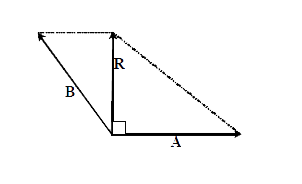A vector which has a magnitude of 8 is added to the vector which lies along the X-axis. The resultant of these two vectors is a third vector which lies along the Y-axis and has a magnitude twice that of . The magnitude of is
To solve the problem, we need to find the magnitude of vector ¯P. We know the following:
1. The magnitude of vector ¯Q is 8.
2. Vector ¯P lies along the X-axis.
3. The resultant vector ¯R lies along the Y-axis and has a magnitude that is twice that of ¯P.
Let's denote the magnitude of vector ¯P as p. Therefore, the magnitude of vector ¯R is 2p.
Step 1: Set up the vectors
- Vector ¯P can be represented as (p,0) since it lies along the X-axis.
- Vector ¯Q can be represented as (0,8) since it has a magnitude of 8 and is added to ¯P.
- The resultant vector ¯R can be represented as (0,2p) since it lies along the Y-axis.
Step 2: Use vector addition
According to the vector addition rule, we can express the resultant vector ¯R as:
¯R=¯P+¯Q
This means:
(0,2p)=(p,0)+(0,8)
Step 3: Break down the components
From the above equation, we can separate the components:
- For the X-component:
p+0=0⟹p=0 (This is not possible since p has a magnitude)
- For the Y-component:
0+8=2p⟹8=2p
Step 4: Solve for p
Now, we can solve for p:
2p=8⟹p=82=4
Conclusion
The magnitude of vector ¯P is 4.
2. Vector ¯P lies along the X-axis.
3. The resultant vector ¯R lies along the Y-axis and has a magnitude that is twice that of ¯P.
- Vector ¯P can be represented as (p,0) since it lies along the X-axis.
- Vector ¯Q can be represented as (0,8) since it has a magnitude of 8 and is added to ¯P.
- The resultant vector ¯R can be represented as (0,2p) since it lies along the Y-axis.
According to the vector addition rule, we can express the resultant vector ¯R as:
¯R=¯P+¯Q
This means:
(0,2p)=(p,0)+(0,8)
From the above equation, we can separate the components:
- For the X-component:
p+0=0⟹p=0 (This is not possible since p has a magnitude)
- For the Y-component:
0+8=2p⟹8=2p
Now, we can solve for p:
2p=8⟹p=82=4
The magnitude of vector ¯P is 4.
Topper's Solved these Questions
- BOOK - AAKASH SERIESCHAPTER - ELEMENTS OF VECTORSEXERCISE - NUMERICAL EXXERCISE (LEVEL -2)21videos
ELEMENTS OF VECTORS
- BOOK - AAKASH SERIESCHAPTER - ELECTROSTATICSEXERCISE - ADDITIONAL PRACTICE EXERCISE (PRACTICE SHEET (ADVANCED) INTEGER TYPE QUESTIONS)5videos
ELECTROSTATICS
- BOOK - AAKASH SERIESCHAPTER - GEOMETRICAL OPTICSEXERCISE - ADDITIONAL PRACTICE EXERCISE (LEVEL-II PRACTICE SHEET (ADVANCED) INTEGER TYPE QUESTIONS)10videos
GEOMETRICAL OPTICS
Similar Questions
A vector →B which has a magnitude 8.0 is added to a vector →A which lies along the x-axis. The sum of these two vector is a third vector which lies along the y-axis and has a magnitude that is twice the magnitude of →A. Find the magnitude of →A
View SolutionResultant of two vector of equal magnitude A is
View SolutionThe resultant of two vectors is perpendicular to first vector of magnitude 6N. If the resultant has magnitude 6√3N, then magnitude of second vector is
View SolutionA vector →F1 is along the positive X-axis. its vectors product with another vector →F2 is ? where →F2 is along Y-axis
View SolutionThe resultant of two vectors A and B is perpendicular to the vector A and its magnitude is equal to half the magnitude of vector B. The angle between A and B is -
 View Solution
View SolutionA resultant of two vectors makes 30∘ with one vector and 45∘ with the other. Find the two vectors if the resultant has the magnitude 15
View SolutionThe resultant of two vectors at right angles is 5 N. If the angle between them is 120∘ and the resultant is √13 then the magnitude of vectors are
View SolutionFind a vector in the direction of vector →a=ˆi−2ˆj that has magnitude 7 units.
View SolutionThe resultant of two vectors makes an angle of 60∘ with one vector and 30∘ with one other. If the magnitude of resultant is 25, the two vectors are of magnitude
View SolutionThe maximum and minimum magnitudes of the resultant of two vectors are 23 units and 7 units respectively. If these two vectors are acting at right angles to each other, the magnitude of their resultant will be
View Solution
